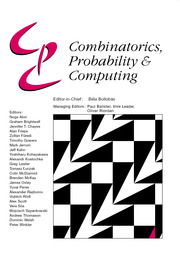Article contents
Dirac’s theorem for random regular graphs
Published online by Cambridge University Press: 28 August 2020
Abstract
We prove a ‘resilience’ version of Dirac’s theorem in the setting of random regular graphs. More precisely, we show that whenever d is sufficiently large compared to  $\epsilon > 0$, a.a.s. the following holds. Let
$\epsilon > 0$, a.a.s. the following holds. Let  $G'$ be any subgraph of the random n-vertex d-regular graph
$G'$ be any subgraph of the random n-vertex d-regular graph  $G_{n,d}$ with minimum degree at least
$G_{n,d}$ with minimum degree at least  $$(1/2 + \epsilon )d$$. Then
$$(1/2 + \epsilon )d$$. Then  $G'$ is Hamiltonian.
$G'$ is Hamiltonian.
This proves a conjecture of Ben-Shimon, Krivelevich and Sudakov. Our result is best possible: firstly the condition that d is large cannot be omitted, and secondly the minimum degree bound cannot be improved.
MSC classification
Information
- Type
- Paper
- Information
- Copyright
- © The Author(s), 2020. Published by Cambridge University Press
Footnotes
This project has received partial funding from the European Research Council (ERC) under the EuropeanUnion’sHorizon 2020 research and innovation programme (grant agreement 786198, D. Kühn and D. Osthus). The research leading to these results was also partially supported by the EPSRC, grants EP/N019504/1 (A. Girão and D. Kühn) and EP/S00100X/1 (D. Osthus), as well as the Royal Society and theWolfson Foundation (D. Kühn).
References
- 2
- Cited by


